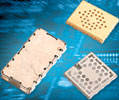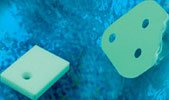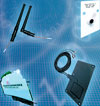

Any electrical and electronic device creates electromagnetic radiation as well as heat when in use. In addition, electromagnetic radiation (EMI - electromagnetic interference) can disrupt the device.
Active and passive EMC (electromagnetic compatibility) can be secured for practically all applications through a broad range of shielding materials.
With the development of increasingly powerful electronic devices and components there is also a dramatic increase of heat generation within the enclosure, while the market demands more compact enclosure dimensions. Notebook computers, for example, are being developed with continuously higher pulsed processors, while notebook enclosures keep getting flatter and smaller. Heat, generated by the processor, additionally accumulates within the tightly measured enclosure interior and therefore impacts performance and efficiency considerably. Therefore, in addition to electromagnetic compatibility, effective thermal management plays an increasingly important role.

Thermally conductive products
In order to reduce the operating temperature of an electronic component, thermal resistance of the heatsink or ventilator should be as low as possible, so there is a need for thermally high conductive materials, which also reduces the thermic resistance. Besides heat conductive pastes, GAP pads, isolators or phase-change materials are also used, depending on the requirements or application. GAP pads are produced and delivered as panels in material thicknesses up to 5 mm. Laird offers a substantial range of standard materials, which can also be modified to custom die-cuts according to requirements.
In order to cover the high thermic needs of electronic devices, heat conductive pastes or phase-change materials can be used, depending on which are more convenient to process. These products offer very good surface coverage to achieve the lowest possible thermal resistance despite their low material strength. Generally, they have a strength of 0,127 mm or less and are used between the cooling component and the heatsink.

So-called gap fillers are optionally available in material strengths from 0,5 mm to 5,0 mm, and are delivered with self-adhesive tape. They vary, depending on use, in their thermal conductivity, viscosity and compression. With T-pli, Laird Technologies offers a market-leading gap filler. This material is composed of a polymer base and shows extremely high thermal conductivity. Other gap-filler materials include the T-flex and T-putty lines. For applications that require high dielectrical properties, such as transistors, a product family of thermally-conductive isolators, called T-gon, is available.
High current PCBs, which produce a lot of heat, can be manufactured to be thermally-conductive through the use of IMPCBs, which are offered by Laird under the name of T-lam. Customers can choose whether they want the thermally-conductive component T-preg in order to produce or laminate their boards, or whether they would like to obtain a readily laminated product for further processing. T-lam can be used for single- and multilayer boards. With the use of T-lam, thermal efficiency increases approximately 10-times, compared to traditional FR4 boards.

© Technews Publishing (Pty) Ltd | All Rights Reserved